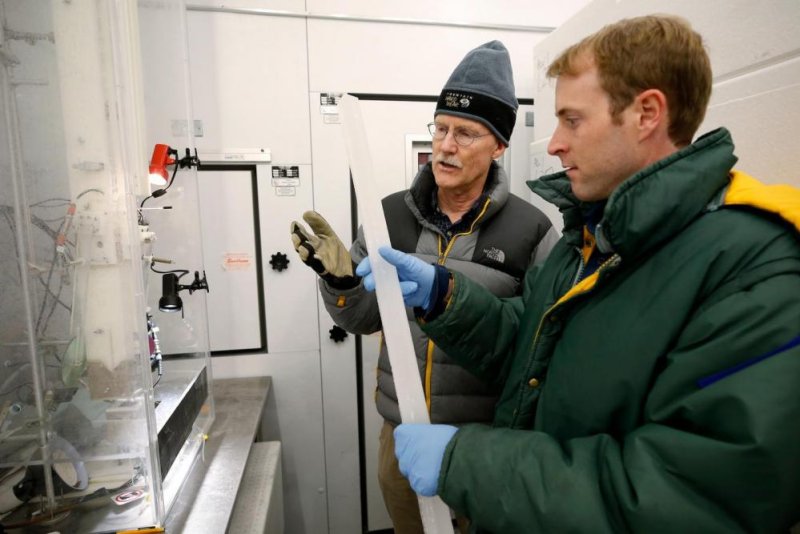Joe McConnell, lead study author, and Nathan Chellman, a doctoral student at the Desert Research Institute, examine an Arctic ice core in DRI's Ultra-Trace Ice Core Chemistry Laboratory in Reno, Nevada. Photo by
DRI
July 10 (UPI) -- Today, economists use a wide variety of sophisticated tools to measure economic output. But how does one measure economic activity that happened 1,000 years ago?
One way is measure changes in lead pollution levels trapped in ancient ice. Using Arctic ice cores, an international team of researchers successfully retraced the economic ups and down of the last 1,500 years.
The findings, published this week in the journal Proceedings of the National Academy of Sciences, revealed the the economic impacts of wars and plagues.
"We all were surprised at how similarly lead pollution varied across this half of the Arctic and how closely those variations coincided with known historical events," Joe McConnell, director of DRI's Ultra-Trace Ice Core Chemistry Laboratory at the Desert Research Institute in Nevada, told UPI. "I certainly was struck by the impacts of plagues on lead pollution."
McConnell and his research partners previously used a single Greenland ice core to track economic activity during the antiquities, from 1100 BC and 800 AD. The study detailed the economic expansion of the Green and Roman empires.
The increase in economic activity across the Mediterranean -- and eventually, throughout Europe -- yielded an increase in lead emissions as a result of silver mining and smelting.
"Silver was the basis of coinage for most of Rome's history, directly linked to their economy and history," McConnell said. "In fact, silver production probably was the main source of atmospheric lead emissions prior to the 19th century Industrial Revolution and so a pretty good -- though certainly not perfect -- proxy or indicator of overall economic activity."
For the newest study, researchers at the Desert Research Institute analyzed 13 ice cores from Greenland and Russia.
Though the ice core analysis happened in Nevada, the research was made possible by international partners in Europe. Scientists from Denmark, Germany, Norway and the United Kingdom.
"The core from the Russian Arctic contributed by the Germans is an especially important example since it would have cost us millions of dollars and taken years to collect that core on our own, and it was a very, very important component in the broad array that underpinned the findings," McConnell said.
The ancient lead pollution signatures revealed a significant increase in economic activity during the Early and High Middle Ages, between roughly 800 to 1300 AD. Lead deposits frozen in the ice also revealed economic downturns in the wake of major European wars and devastating disease outbreaks, including the Black Plague.
With the advent of the Industrial Revolution, the sources of lead pollution shifted, but the link between lead deposits and economic activity remained.
"After the start of the Industrial Revolution, widespread coal, heavy oil, and leaded gasoline burning resulted directly in high levels of lead emissions and so linked lead pollution to energy production and transportation, also good indicators of overall economic activity," McConnell said.
Beginning in the latter half of the 20th century, environmental regulations, including the 1970 Clean Air Act, worked to disconnect lead pollution from economic activity.
"It is a great example of what a well-designed government policy can do to clean up the environment, even the remote Arctic, while the economy continues to expand," McConnell told UPI.
Despite the disconnection and short-lived decreases in lead pollution, the wide-angle view of the contaminants leaves no doubt about the impacts of the global economy.
"Seeing on one graph and in great detail the timing and extent of the 250 to 300-fold increases in Arctic lead pollution during the past 1500 years is a pretty powerful reminder of how much human activities have altered the planet," McConnell said.















